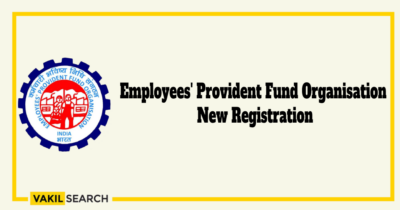Read this blog to understand the differences between EPS and EPF in India.
Employees’ Pension Scheme and the Employees Provident Fund (EPF) were established to assist workers in saving for their retirement. The Employee’s Provident Fund and Miscellaneous Provision Act, of 1952, shows several employee programs, all of which must be administered by the Central Board of Trustees (CBT).
Despite this, the features, benefits, and mode of operation of the two systems are distinct. Explore the benefits and drawbacks of EPF and EPS by comparing the two. Let’s see about EPF vs EPS.
What Is an EPF, and How Does It Work?
The Employee Provident Fund is one of India’s most well-known government-managed savings programs (EPF). The Ministry of Labor in India is responsible for administering EPF plans. This scheme is the cornerstone of the Employee Provident Fund and Miscellaneous Provisions Act of 1952. Employees’ Provident Fund Organization (EPFO) oversees this retirement savings plan.
What is an Employee Pension Scheme?
The EPS was created in 1995 so existing, and future workers could access pension benefits. The government of India approves of the scheme. Consequently, the strategy guarantees financial success (pension amount). In light of this, EPS can be considered a secure retirement income.
What Are EPF Accounts, and How Do They Work?
The EPF system, administered by the Employees Provident Fund Organization (EPFO), allows participants to save for retirement tax-deferred. The employee and the firm each contribute 12% of the employee’s base salary and DA to the plan.
Employee contributions are allocated entirely to the EPF, whereas employer contributions are made to the Employee Provident Scheme (EPS) (9.34% of which goes to the EPF).
Employees can access their whole EPF balances upon retirement or after being unemployed for two months or more, depending on the conditions. In the event of a job change, an employee’s EPF balance can be moved from their previous employer to their new one.
A different UAN has been assigned to each EPFO contributor. Because the UAN is tied to the person’s employment record, the employee can use it to access a variety of EPF records even if they leave or change jobs.
Click Here to more about: https://unifiedportal-emp.epfindia.gov.in/epfo/
Direct Benefits of EPF
Tax-saving Benefits: Contributions made by the employee to the EPF are tax-deductible under Section 80C of the Income Tax Act. The interest earned is also tax-free. The entire corpus remains tax-free if withdrawn after 5 years of continuous service.
Capital Appreciation: The EPF offers capital appreciation as it earns interest at a rate set by the Government of India, and contributions are made monthly.
Retirement Corpus: It helps build a retirement corpus, providing financial security and independence during retirement.
Financial Emergency: Funds accumulated in the EPF account can be partially withdrawn during financial emergencies for specific purposes.
Unemployment: Benefits are available during unemployment. After one month of job loss, 75% of the corpus can be withdrawn, and the remaining 25% after two months.
Death Benefits: In case of the employee’s demise, the nominee receives the entire EPF corpus, providing financial assistance to the family.
Easy Access: Universal Account Number (UAN) allows easy access to PF accounts through the member portal, facilitating PF transfer when changing jobs.
Direct Benefits of EPS
Pension Upon Retirement: EPS members become eligible for pension benefits at age 58, with at least ten years of service. They can withdraw monthly pension benefits using the EPS Scheme Certificate.
Pension on Early Departure: Members can withdraw the entire sum at age 58 if they can’t complete ten years of service before that, but they won’t receive monthly pension benefits.
Pension for Total Disablement: Permanently disabled members receive a monthly pension regardless of completed service, starting from the date of disablement.
Pension for Family in Case of Demise: If a member passes away while in service, their family is eligible for pension benefits if the employer deposited funds for at least one month. If the member completes ten years of service and dies before 58, their family is also eligible.
Calculation of EPF
The calculation of EPF contributions is based on a percentage of the employee’s basic salary and dearness allowance.
Here’s How it works:
Employee’s Contribution: The employee contributes 12% of their basic salary and dearness allowance to the EPF. For example, if the employee’s basic salary and dearness allowance are Rs. 14,000, their contribution would be 12% of Rs. 14,000, which is Rs. 1,680.
Employer’s Contribution to EPF: The employer also contributes to the EPF, but it’s divided into two parts:
- 3.67% of the employee’s basic salary and dearness allowance, goes to the EPF. For the example above, it would be 3.67% of Rs. 14,000, which is Rs. 514.
- 8.33% of the employee’s basic salary and dearness allowance, goes to the Employee Pension Scheme (EPS). In this example, it would be 8.33% of Rs. 14,000, which is Rs. 1,166.
Total EPF Contribution: The total contribution towards the EPF account of the employee is the sum of the employee and employer contributions towards EPF. In this case, it would be Rs. 1,680 (employee’s contribution) + Rs. 514 (employer’s EPF contribution) = Rs. 2,194.
Calculation of EPS
The Employee Pension Scheme (EPS) provides a monthly pension to members after retirement. The pension amount is calculated using the following formula:
Monthly Pension = (Pensionable Service x Pensionable Salary) / 70
- Pensionable Service: The total years of service that is eligible for pension benefits.
- Pensionable Salary: The average salary considered for pension calculation, subject to a maximum cap.
For example, if an individual has a basic salary and dearness allowance of Rs. 25,000 and their employer contributes Rs. 2,082.50 (8.33% of Rs. 25,000) to EPS, but the maximum pensionable contribution is Rs. 1,250, the surplus amount of Rs. 832.50 would be added to the employer’s contribution towards the EPF account.
The specific pension amount an individual receives will depend on their years of service and average pensionable salary.
Benefits and Tax Breaks From EPF Contributions
The plan’s interest’s current annual percentage yield (p.a.) is 8.1 percent. In conjunction with the Ministry of Finance, the EPFO’s Central Board of Trustees annually examines the EPF interest rates. Section 80C of the Income Tax Act, 1961, allows for tax exemptions of up to Rs.1.5 million for contributions to an employee’s pension fund (EPF). Also, interest income is not subject to taxation.
How Does EPS Work?
For Indian citizens, the EPS has official support from the government. The nominees will be entitled to receive a pension under this plan. The employee’s base pay and DA account for 12%, while the company contributes 8.33%. However, Rs.1,250 is the maximum amount to be donated to the plan. The previous cap of Rs. 750 has been raised to Rs. 1,250. (from Rs. 541). Previously, the annual limit was Rs.6,500; today, it’s Rs.15,000.
No one is required to make any pension payments. Pension amounts can be confirmed with a UAN through the EPFO website. Pension eligibility is reached after ten years of service and age 50.
Qualifications for Receiving a Pension
Here are the criteria you need to fulfill to qualify for pension payments.
- They need to be active members of the EPFO.
- The candidate’s work history must be at least ten years long.
- The minimum age to participate is 58.
- Those who wait until they are 60 to draw their pension will receive an annual increase of 4%.
Experience seamless compliance. Get started with Vakilsearch: Your PF Registration Partner!
Difference Between EPF and EPS
Below is the table that gives EPS and EPF differences:
| Parameters | EPF | EPS |
| Applicability | For-profit organizations with over 20 employees must sign up for EPF. | Individuals must pay EPS if they are a member of EPFO and make payments to their EPF account. |
| Eligible employers | It’s available for usage by everyone in the office. | Employees who earn up to Rs.15000 per month in combined base pay and dearness allowance are eligible to apply. |
| Contribution by Employees | Total compensation (base pay + dearness allowance) x 12% | Without any help |
| Contribution from Employer | The corporation matches 12% of your contribution. Yet 3.67 percent of this sum goes to the EPF. | Employer contributions to EPS make up the remaining 8.33% of the total. |
| Maximum Contribution | Twelve percent of base pay is required as a contribution. | You can only put in Rs.1250 (or 8.33%) of your earnings up to Rs.15000. |
| Interest Rate | In this system, interest is computed monthly and paid once a year at the end of the fiscal year. Additionally, interest rates are set and reviewed often by the government. At the moment, the interest rate on EPF accounts is 8.50%. | No interest is paid. |
| Funds Withdrawal | You are eligible for a withdrawal if you have been unemployed for two months. | After reaching the age of 58, pension eligibility is determined. |
| Premature Withdrawal | The early withdrawal penalty is waived in certain circumstances, such as marriage, having a child, paying a mortgage, leaving a job, etc. If, and only if, several preconditions are satisfied. |
You can start receiving your pension early after you hit 50. A lump sum payoff is available if you are at least 58 years old or will be leaving your employer in less than ten years. |
What a “Scheme Certificate” Means?
If an EPFO member has less than ten years of service with an employer and is under the age of 58, he can acquire a scheme certificate to continue his EPFO membership at a new company. After working for the company for ten years, he will be eligible for the scheme certificate.
The planning certificate can be used for either the withdrawal of EPF payments or the application for pension benefits after the member turns 58. It helps surviving family members get pension benefits after the death of a pensionable family member.
Can EPF and EPS Be Transferred?
Each member who contributes to the plan receives a Universal Account Number (UAN) from the Employees Provident Fund Organisation (EPFO). Since the UAN does not change regardless of where the member has worked, it serves as the primary identifier for all employment-related data. If an employee gives his new company his UAN number, he can continue making EPF contributions even after switching employment. Once UAN is activated and Aadhaar and PAN card are linked, financial transactions can be conducted electronically.
Conclusion
Although they have some similarities, EPF and EPS are two different benefit plans for workers. To obtain a wage, you must comprehend the significance of such programs. In contrast to the EPF, which only provides a lump sum payment at retirement, the EPS ensures a regular Income tax return for the remainder of your life.
Both plans are valuable because they allow employees to set aside money for a rainy day, and retirement is a primary financial goal. You can take the help of Vakilsearch; their professionals can guide you.
FAQs
What is the contribution rate for both the employee and employer in the EPF and EPS?
The contribution rate for both the employee and employer in the EPF is 12% of the basic salary and dearness allowance. Out of the employer's contribution, 8.33% is directed towards the Employees' Pension Scheme (EPS), and the remaining 3.67% is contributed to the EPF.
How can employees check their EPF balance and contribution details?
Employees can check their EPF balance and contribution details by visiting the EPFO Member Portal or the UMANG app.
Can employees withdraw funds from their EPF and EPS accounts, and if so, under what conditions?
Yes, employees can withdraw funds from their EPF and EPS accounts under certain conditions, such as retirement, resignation, or in case of a medical emergency. The withdrawal process and eligibility criteria vary depending on the reason for withdrawal.
What are the benefits of the EPS for retired employees?
The EPS offers several benefits for retired employees, including a monthly pension, a life insurance benefit, and a family pension in case of the employee's death.
Are there any tax implications associated with EPF and EPS contributions?
EPF and EPS contributions are tax-exempt up to a certain limit, and any interest earned on these contributions is also tax-free.
How can employees transfer their EPF and EPS accounts when changing jobs?
Employees can transfer their EPF and EPS accounts when changing jobs by submitting a transfer claim online through the EPFO Member Portal or by submitting a physical transfer claim form to the new employer
Also, Read:









